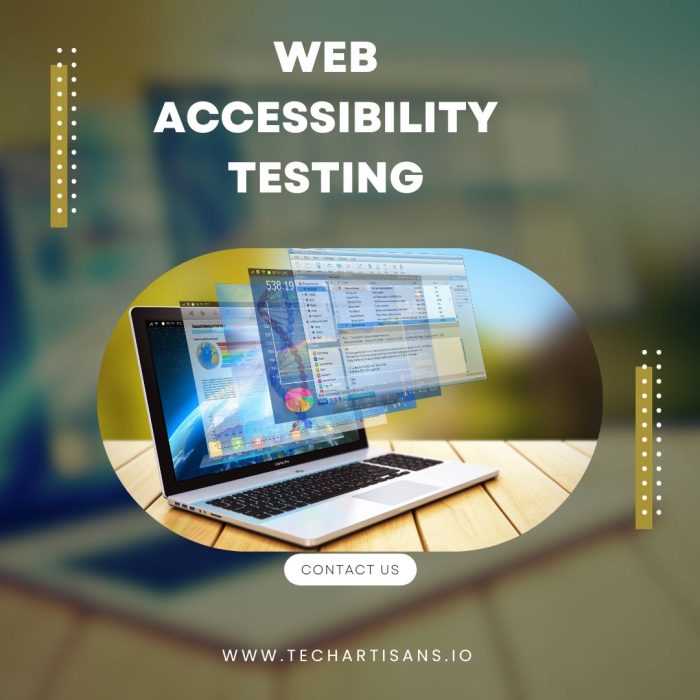In today’s digital age, web accessibility is vital for businesses of all sizes, especially small to medium-sized ones. Making your website accessible broadens your customer base, ensuring it caters to people with varying abilities (visual, auditory, cognitive, or motor). Web accessibility testing ensures compliance with global standards, improving user experience, SEO performance, visibility, reputation, and conversions. Web Accessibility Testing is critical to ensure your website is universally accessible, catering to users with diverse abilities. To further understand the legal requirements and benefits of ADA compliance for websites, visit Should Your Website Be ADA Compliant? So, let’s explore different tools and various benefits of website accessibility.
What is Web Accessibility?
Web Accessibility, a term increasingly gaining attention in the digital landscape, is centered around creating an online space where everyone, regardless of their abilities or disabilities, can access, understand, and interact seamlessly. For more insights into the fundamental steps involved in deploying a website with these considerations, read Fundamental Steps to Deploying Website.
Importance Of Web Accessibility
Web accessibility is crucial, offering everyone equal access, including those with disabilities. It’s both an ethical obligation and a legal requirement in many places. It expands your customer base, enhances satisfaction, and boosts retention. It also improves SEO, leading to higher rankings and more traffic. Prioritizing web accessibility demonstrates inclusivity and social responsibility, enhancing your brand’s reputation.
Benefits for Businesses and Users
Ensuring web accessibility creates an inclusive digital environment, benefitting businesses and users. Learn about the Benefits of Having a Website that is accessible to all. Businesses enjoy increased traffic and improved SEO rankings, while users experience seamless navigation, regardless of their abilities, enhancing overall user satisfaction.
Why Web Accessibility Matters?
In a digital-first world, web accessibility has transcended from mere options to unambiguous necessities. Let’s explore why web accessibility matters and how it can transform your business landscape.
Legal Implications and Standards
Web accessibility has legal implications. To understand these better, especially in terms of ADA compliance, explore Web Accessibility Laws and Regulations. Laws like the ADA and standards like WCAG make compliance mandatory. ADA prohibits discrimination against individuals with disabilities, including in the digital space, which could lead to legal issues if your website isn’t accessible. WCAG ensures international criteria are met. Non-compliance can result in missed customers and potential lawsuits.
Enhancing User Experience and Brand Perception
Web accessibility enhances user experience by offering easy navigation and understandable content, boosting user engagement and loyalty while reducing bounce rates. It also improves brand perception, showcasing your commitment to inclusivity and equal access, building trust among current customers, and attracting a broader audience for business growth.
Overview of Web Accessibility Testing
Web Accessibility Testing ensures that your website’s content and features can be easily accessed and used by everyone. For practical guidelines on this, consider reading Web Accessibility Testing including individuals with disabilities. This is done by testing your website against established accessibility standards such as the WCAG.
The significance of Web Accessibility Testing lies in its ability to identify potential barriers that might prevent disabled users from fully interacting with your website. Doing so can ensure a seamless user experience for all, enhancing inclusivity and showing your commitment to equal access. Importantly, it also helps maintain compliance with legal requirements, safeguarding your business from potential lawsuits.
Different Methods
Web Accessibility Testing methods include Automatic Scanning for efficient but potentially incomplete results. Semi-automatic Scanning combines automation and human judgment for improved accuracy and Manual Testing by accessibility experts for the most accurate but time-consuming evaluations.
Tools for Web Accessibility Testing
Web Accessibility Testing relies on diverse tools, from automated scanners to manual aids. A comprehensive list of tools can be found in Web Accessibility and Its Importance to identify accessibility barriers and enhance user experiences. Let’s explore these essential tools.
W3C’s Evaluation Tools List
The W3C’s Evaluation Tools List offers a wide range of tools for Web Accessibility Testing, including automated, manual, and semi-automatic options. Its detailed categorization helps businesses choose the right tool, and the W3C’s vetting ensures credibility and effectiveness. It’s a reliable starting point for businesses getting started with web accessibility.
WAVE
WAVE (Web Accessibility Evaluation Tool) simplifies web accessibility testing with visual issue representation. It offers automated and manual testing, flagging problems on your webpage for easy fixes. WAVE reveals hidden accessibility issues and provides instant reports when you input your URL, making it a valuable resource for enhancing website accessibility.
Accessibility Checker
Accessibility Checker is a strong online tool for web accessibility evaluation. It supports various standards like WCAG and Section 508, offering instant analysis via URL, HTML file, or code input. It provides a detailed report with categorized issues and checks compliance with multiple guidelines, aiding businesses in web accessibility testing.
BrowserStack Accessibility Testing
BrowserStack Accessibility Testing is a cloud-based platform for comprehensive web accessibility testing. It covers multiple devices, browsers, and operating systems, including a real device lab with over 2000 options. Automation reduces testing effort, resulting in a thorough accessibility evaluation, issue identification, and improved user experience.
Usability Geek’s Recommended Tools
Usability Geek suggests various Web Accessibility Testing tools, such as AChecker, Cynthia Says, FAE, MAGENTA, TAW, WAVE, and Sa11y, each with unique strengths. Select the one that suits your business needs and website complexity.
Practical Steps for Ensuring Web Accessibility
Implementing web accessibility is essential to your business strategy, enabling a wider audience to interact with your website effectively. Here are some practical steps that will guide you in ensuring that your website is fully accessible to all users, regardless of any disabilities they may have.
Using Browser Extensions for Testing
Browser extensions are essential for web accessibility testing. For more information on enhancing the user experience through design, visit Why UX Design is Important which is available on Chrome, Firefox, and Safari browsers. Examples include aXe for automated testing with no false positives and SiteImprove for comprehensive automated and manual testing. These tools help efficiently identify and fix accessibility issues, improving the user experience for all site visitors.
Human Evaluation in Conjunction With Tools
Automated tools find technical issues, but human evaluators are essential for assessing user experience, functionality, usability, and navigation. Combining both ensures comprehensive web accessibility testing for an inclusive user experience.
Regular Monitoring and Updates
Regular monitoring and updates are vital for maintaining web accessibility. As technology and content change, new challenges may arise, so schedule periodic testing to ensure ongoing compliance. Use evaluation findings to update your design and content, enhancing inclusivity and user-friendliness.
Intersection of Usability and Accessibility
While often considered in their capacities, the concepts of usability and accessibility are essentially intertwined. Explore more at UX vs UI Design to understand their connection better collectively contributing to the user-friendliness and inclusivity of a website. Let’s delve into how these two aspects intersect and the implications of their interplay for web accessibility.
How Improving Accessibility Enhances Usability
Enhancing web accessibility improves usability and creates a more inclusive and user-friendly website. For insights into making your website more responsive and accessible, see Why Responsive Web Design Important. It achieves this through universal design, better navigation, readable content, media accessibility, effective communication, error handling, compatibility, faster loading, reduced bounce rates, and increased user engagement.
Real-World Examples of the Overlap
Amazon’s redesign with clearer labels boosted sales, demonstrating the link between web accessibility and usability. The BBC’s subtitles made content accessible to the deaf and improved usability for those who prefer reading. These examples highlight how web accessibility improvements can enhance usability for all users.
Benefits of Ensuring Web Accessibility
Web accessibility offers businesses tangible benefits, from enhancing user experience to improving SEO. It’s not just about compliance and ethics; it’s a strategic advantage.
Boosting Brand Perception
Ensuring web accessibility boosts brand perception by demonstrating a commitment to inclusivity and equality. An accessible website communicates that your business values all customers, regardless of their abilities or disabilities. This positive image enhances customers’ trust and loyalty, distinguishing your brand as socially responsible and customer-focused in a competitive market.
Avoiding Legal Complications
Non-compliance with web accessibility standards can lead to legal complications, including lawsuits and hefty fines. By ensuring your website is accessible, you safeguard your business against such pitfalls, maintain your reputation, and demonstrate adherence to international accessibility norms.
Expanding the User Base
An accessible website broadens your reach by catering to a diverse audience, including those with disabilities. Approximately 15% of the world’s population experience some form of disability. By ensuring web accessibility, you can tap into this substantial user base, increasing your potential customer pool and improving business prospects.
Conclusion
Web accessibility testing is essential in our digital world, expanding your customer base and promoting inclusivity. Prioritize it for a better user experience, improved SEO, and legal compliance. Enhanced usability increases engagement, lower bounce rates, and customer loyalty. Investing in web accessibility aligns with legal, ethical, and social responsibility standards, enhancing your brand image. Read more about the Benefits of Having an Accessible Website for a deeper understanding of its importance. Make it integral to your business strategy for an inclusive and rewarding digital landscape.







